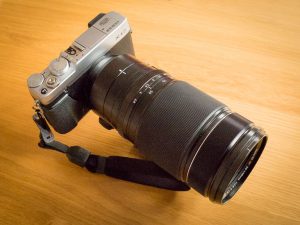Transition to Fuji – Part 3
For the past few years, I have been actively looking for an alternative to my Canon DSLR and purchasing equipment to try on a long term basis. At the conclusion of the previous article in this series, I was using a Fuji X-Pro1 with the XF 18-55 f/2.8 – f/4 lens. I really liked the lens, the X-Pro1 slightly less so. Not that it is a bad camera, but it comes from Fuji’s first generation of models incorporating the X-Trans sensor. Sometimes it shows.

My Fuji X-E2 and XF 50-140. The lens is excellent, but is substantially larger than most of the others in what is otherwise a compact system.
(Click on the image for a larger version)
When it comes to choosing a camera, the only options available to most of us are to read reviews and handle the gear in a shop prior to purchase. Occasionally we will know someone who already owns what we are interested in and can provide feedback on their experience. If we are lucky, we could get to try it but there is a lot of trust involved for anything other than a quick test with the owner present.
Sometimes, manufacturers will arrange longer term tests. The best example is Olympus’ Test and Wow scheme. It allows a minimum of a full day to try out its cameras and most of the lenses in its range without charge. In the UK, Fuji does something similar through Calumet, but you have to know about the scheme and contact Calumet directly to avoid a rental fee. Unlike Olympus, there is no online booking option. The Olympus scheme was useful, although in my case perhaps not in the way the company would have wanted. I discovered that the layout of the E-M1 controls did not suit me.
The exposure compensation dial is easy to move inadvertently, as is the lever on the front which sets focussing options. I once spent some time wondering why the camera would not focus, before finding the control on its manual position. While not exactly slow, the autofocus is not snappy either, despite Fuji’s numerous firmware improvements. Combined with significant lag on the part of the EVF, it not a camera to use when the subject is moving. Granted that there is an optical viewfinder, but it has limited utility. It is inaccurate, especially at close distances, and only caters for a limited range of focal lengths.
When an opportunity arose to purchase an immaculate ex-demo X-E2 for less than the price of a used model, I took it. There is only an interval of a year or so between the launch of the two cameras, but the X-E2 addresses many of the issues I was experiencing with the X-Pro1. It was a revelation and became my normal walkaround camera. Yet despite using it for much of my recent work, I was still dependent on my DSLR a lot of the time.
One of the reasons for using the DSLR is that I only had Lee Filter adapters for its lenses. In anticipation of my planned trip to Scotland last autumn, that was readily addressed without too much expense. The other issue was a lack lenses with focal lengths ranging either side of the XF 18-55. Resolving that did involve some financial pain. In the event, the XF 40-150 proved its worth while I was in Scotland, the XF 14 less so. That was in line with my expectations, as I rarely shoot with a wide-angle lens. Had the XF 14 not been attractively priced, such that I would not lose much on any resale, I would probably have foregone it. Overall, buying was a better option than renting for the week.
I came back from Scotland having used my Fuji cameras for much of the time and was pleased with the results I had obtained. Since then, they have become the foundation of my photography. In the final instalment of this series, I will describe the merits of the Fuji X-series system as I have experienced it.